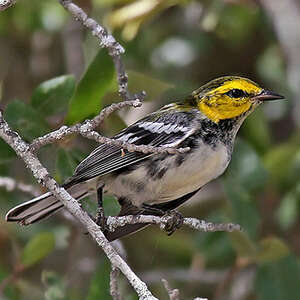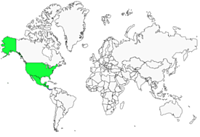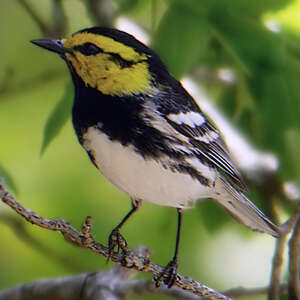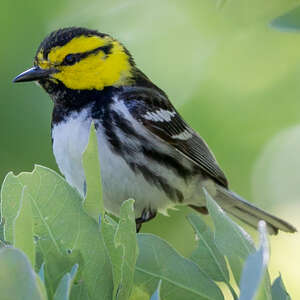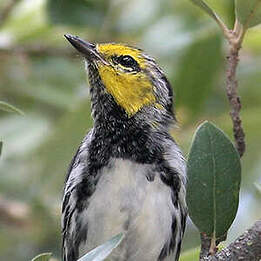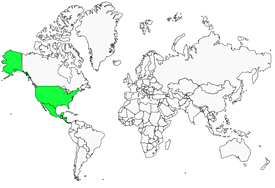Golden-cheeked Warbler
Setophaga chrysoparia - Paruline à dos noir
Identification
The Golden-cheeked Warbler is part of the virens group, meaning the group of the Black-throated Green Warbler, a small group of five related warblers of the genus Setophaga whose males have black throats. It is mainly the arrangement of colors on the head that differs and allows for identification. On the other hand, the female and juvenile plumages can be confusing.
The head of the male breeding Golden-cheeked Warbler is black above (crown and back of the neck) and below (chin and throat) while the sides are lemon yellow, except for a black stripe that runs from the beak to the neck passing through the eye.
The sparrow's coat is black, as well as the upper and sides of the chest, and the top of the flanks. The middle of the chest, the stomach and the under-tail coverts are white. The back of the flanks is spotted with black.
The wings and tail are gray. The first show two large white wing bars formed by the ends of the large and medium coverts. The second show a lot of white in the three outer pairs of rectrices, which can only be seen from below or when the bird is in flight. The eye appears black. The beak and legs are black.
By comparison, its close relative, the Black-throated Green Warbler, shows a greenish-dark olive crown and mantle and a yellow belly.
The adult female looks like the male, but with less sharp colors. The crown, the back of the neck and the coat are greenish olive and striped with black. The stripes are particularly clear on the mantle which can also be invaded by gray. The chin and throat are white to pale yellow. This latter, more or less invaded by black, is bordered by two black malar stripes clearly visible. The black of the chest and flanks is less extensive and less firm than in the male.
The breeding plumage is not acquired in the year following birth. The second-year male is quite similar to an adult female.Look at the chin which is always clear in the female. The juvenile looks like a female, but it is very gray, with blackish spots on the chest and flanks. The yellow of the head may not be obvious at first. The intermediate plumages are a real puzzle. Thus, the first winter can be confused with a Golden-cheeked Warbler of the same age. Only the strictly yellow cheeks with their black line and the white lower abdomen distinguish them.
Subspecific information monotypic species
Foreign names
- Paruline à dos noir,
- Reinita caridorada,
- mariquita-de-bochecha-dourada,
- Goldwangen-Waldsänger,
- Geelwangzanger,
- Parula guancedorate,
- gulkindad skogssångare,
- Gulkinnparula,
- horárik čiernochrbtý,
- lesňáček zlatolící,
- Gyldenkindet Sanger,
- teksasinkerttuli,
- bosquerola caragroga,
- lasówka żółtolica,
- dzeltenvaigu ķauķis,
- Золотощёкий лесной певун,
- キホオアメリカムシクイ,
- 金颊黑背林莺,
- 金頰黑背林鶯,
Voice song and cries
The Golden-cheeked Warbler has two main calls. The first is a short phrase of about 5 notes which is reminiscent of the song of the Reed Bunting. It usually ends with two drawn and vibrating notes, the second of a higher pitch. This call is heard at the start of the breeding season on its territory and in the presence of the female. The second is a bit more complex and longer, with variations in pitch and quality of the notes, some reminiscent of Fringilla song. It also ends with a hard note. It comes later, serves a territorial function, and is heard at the borders of the territory. The song is of the same type as that of the Black-throated warbler, but harsher.
The usual contact call is a slightly muffled tyip. This is the call heard near the nest or when foraging in the vegetation. In flight, it makes sharp sit calls, very similar to those of its close cousins.
Habitat
The Golden-cheeked Warbler is one of the most specialized warbler species in terms of habitat. It nests in oak woodlands on slopes of the hill country.
Among the companion species, one is essential to them, that is the Ashe juniper (Juniperus ashei) in which they most often build their nests and use the bark as a building material, then others such as maples (Acer grandidentatum), walnuts, sycamores ... They prefer stands in which trees do not exceed 10 meters in height and avoid mature pure juniper stands. The presence of a nearby water course is a usual criterion for the choice of territory.
In migration, the Golden-cheeked Warbler is less demanding. It can be found in various open wooded habitats, in bushes and thickets.
In winter, it exclusively occupies mixed high altitude forests of pines and oaks of Central America.
Behaviour character trait
The Golden-cheeked Warbler is a medium-distance migrant bird. Its migrations take it from Texas to Central America and back.
It is an early migrant, whether for the climb to nesting sites in February-March or for the descent to wintering sites at the end of June to early August.
Golden-cheeked Warblers usually stay in small groups outside the breeding season. On the nesting sites, they are territorial and monogamous. Males arrive a few days before females, taking the time to establish their territory. But it is the female who will choose the nest site.
The vocal activity is maximum in April and then declines to stop in late June. The sharp notes of young birds begging for food are heard in May and June. The autumn migration begins at the end of June-beginning of July and most of the birds have left by August.
Dietfeeding habits
Like most warblers, the Golden-cheeked Warbler mostly feeds on insects and spiders. Caterpillars are especially sought after during the breeding season. It hunts mostly in the shrubs in ravines and at the bottom of wooded slopes. It jumps from branch to branch, collecting its prey on the foliage. It also captures flying insects through short flights. On the other hand, it generally does not go to the ground. Like many other insectivores, it kills its toughest prey and softens it by hitting it against a branch before consuming it or offering it to its young.
Reproduction nesting
The Golden-cheeked Warbler typically joins its reproductive area around mid-March, with the male arriving a few days before the female.
The birds are faithful to their breeding site and come back year after year.
The male is vocal upon arrival. He sings from an exposed perch, high ridge, or dominant branch of the canopy. When defending his territory, he sings at the edges and is not afraid to fly long distances from one point to another.
It is the female who chooses the nesting site, usually at the fork of a juniper, although this species is not exclusive.
It is also the female who builds the nest, mainly made of juniper bark but also various other materials such as spider webs, lichens, mosses, and herbs. The nest blends into its bark environment and is well camouflaged. The inside is lined with hairs, feathers and rootlets.
The clutch consists of 3 to 5 white or cream eggs with dark spots mostly located at the large end. The female incubates for about 12 days. Both parents feed the hatchlings who leave the nest about 9 days after hatching.
They continue to feed their offspring for a while yet, with each one taking care of part of the brood.
The Golden-cheeked Warbler raises one brood per year; a replacement brood can be seen if the first one fails.
Geographic range
Threats - protection
IUCN conservation status
concern
in the Wild
threatened
evaluated
The Golden-cheeked Warbler is classified as an endangered species. Two main threats face it, firstly the loss of its habitat but also parasitism. Its highly localized reproduction area is in an area, central Texas, subject to high human pressure which reduces and fragments its specific habitat as human development progresses. The Golden-cheeked Warbler also suffers habitat loss in its wintering area by deforestation and conversion to pasture or by commercial logging of timber. The second important threat is the parasitism of broods mainly by the Brown-headed Cowbird. The Golden-cheeked Warbler is now the subject of conservation measures, sanctuarization of certain reproduction areas and the fight against the Brown-headed Cowbird. The fact that the Golden-cheeked Warbler is attached to only one type of habitat is an unfavorable factor for its conservation.
Sources of information
- IOC World Bird List (v14.1), Gill, F and D Donsker (Eds). 2024-04-18.
- The warbler guide, Tom Stephenson and Scott Whittle
- The North American Bird Guide, David Sibley
- Warblers, Dunn Jon/Garrett Kimball
- All About Birds, Cornell Lab of Ornithology
- HBW Alive,
- xeno-canto, Sharing bird sounds from around the world,
Other sources of interest
 Specification sheet created on
28/10/2023 by Florent Lecourtier
Specification sheet created on
28/10/2023 by Florent Lecourtier partially rewritten on 00/00/0000 by Jean François
Translation by AI Oiseaux.net
published: 18-04-2020 - Updated: 23-04-2020
© 1996-2024 Oiseaux.net
- Accipitriformes
- Aegotheliformes
- Anseriformes
- Apodiformes
- Apterygiformes
- Bucerotiformes
- Caprimulgiformes
- Cariamiformes
- Casuariiformes
- Charadriiformes
- Ciconiiformes
- Coliiformes
- Columbiformes
- Coraciiformes
- Cuculiformes
- Eurypygiformes
- Falconiformes
- Galliformes
- Gaviiformes
- Gruiformes
- Leptosomiformes
- Mesitornithiformes
- Musophagiformes
- Nyctibiiformes
- Opisthocomiformes
- Otidiformes
- Passeriformes
- Pelecaniformes
- Phaethontiformes
- Phoenicopteriformes
- Piciformes
- Podargiformes
- Podicipediformes
- Procellariiformes
- Psittaciformes
- Pterocliformes
- Rheiformes
- Sphenisciformes
- Steatornithiformes
- Strigiformes
- Struthioniformes
- Suliformes
- Tinamiformes
- Trogoniformes

